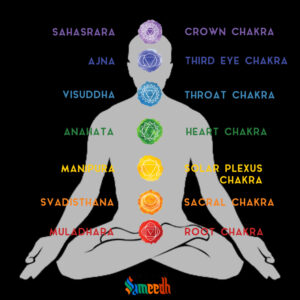The Muladhar chakra, also known as the root chakra, is one of the seven main energy centers in the body according to Hindu and Buddhist teachings. It is located at the base of the spine and is associated with the element of earth. The muladhar chakra is believed to govern our connection to the physical world, including our sense of security, stability, and basic needs.

- Location: Base of the spine
- Color: Red
- Element: Earth
- Significance: Represents stability, grounding, and basic survival instincts.
- Deity: Ganesh, the elephant-headed god, is often associated with Muladhara. He is revered as the remover of obstacles and the lord of beginnings.
The Muladhar Chakra, commonly known as the Root Chakra, is the first and foundational chakra in Hinduism in 7 Chakras. It is associated with the sense of grounding, stability, and the connection to the physical world. The Muladhar Chakra is located at the base of the spine, near the perineum. The traditional color associated with the Root Chakra is red, symbolizing energy, vitality, and the connection to the Earth. The element associated with the Muladhara Chakra is Earth. This element represents stability, solidity, and a sense of being grounded. The symbol of the Muladhara Chakra is a four-petaled lotus flower. Each petal is associated with different qualities related to the chakra.
The Muladhar Chakra is considered the foundation of the chakra system, providing a sense of security, stability, and a connection to the physical body and the material world. Lord Ganesh, the elephant-headed god, is often associated with the Muladhar Chakra. Ganesh is revered as the remover of obstacles and the lord of beginnings.
The Muladhar Chakra is associated with survival instincts, basic needs, and the sense of security. It influences aspects such as food, shelter, and a sense of belonging. When this chakra is balanced and open, it is believed to give us a strong foundation and a sense of belonging in the world. On the other hand, if the muladhar chakra is blocked or imbalanced, it can lead to feelings of insecurity, fear, and a lack of connection to the physical world.
To balance and open the muladhara chakra, some practices that may be helpful include:
Grounding exercises, such as walking barefoot on the earth or meditating with your feet planted firmly on the ground.
Practicing yoga poses that focus on the lower body, such as downward facing dog or mountain pose.
Using essential oils or crystals that are associated with the root chakra, such as sandalwood or red jasper.
Visualizing the color red or the symbol of the muladhara chakra to help bring awareness and energy to this chakra.
The Muladhar Chakra serves as the foundation for the other chakras. A balanced Root Chakra contributes to the overall stability and balance of the entire chakra system.
Balancing the Root Chakra is considered important for establishing a solid foundation in life, feeling secure, and cultivating a sense of well-being. Practices that focus on grounding, stability, and connection to the Earth can contribute to the harmonious functioning of the Muladhar Chakra.
